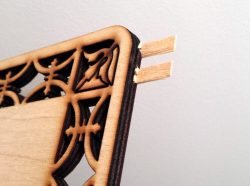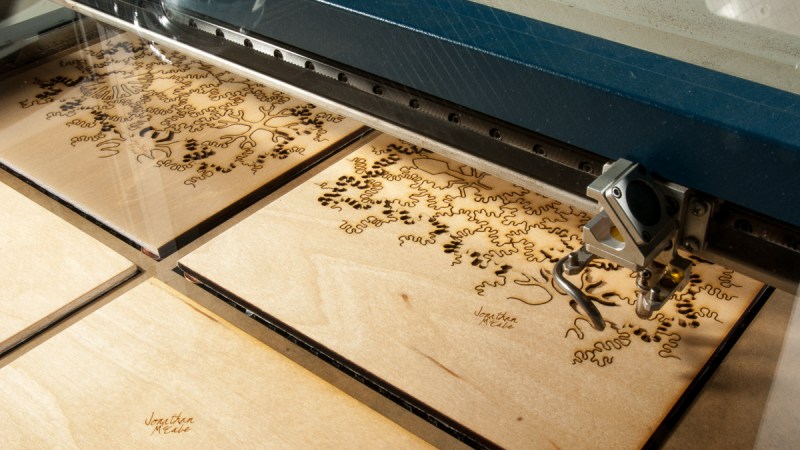Plywood laser-cuts fairly well but has drawbacks when used in serious production runs, as [Marie] explains in a blog post about a quest for the ultimate laser-cutting plywood. One of the things [Nervous System] makes and sells is generative jigsaw puzzles, and they shared their experience with the challenges in producing them. The biggest issue was the wood itself. They ended up getting a custom plywood made to fit their exact needs, a process that turned out neither as complex nor as unusual as it may sound.

Plywood is great because it’s readily available, but there are some drawbacks that cause problems when trying to do serious production of laser-cut plywood pieces. Laser cutting works best when the material being cut is consistent, but there can be areas of inconsistent density in plywood. If the laser encounters an unexpected knot somewhere in the wood, there is no way to slow down or to increase power to compensate. The result is a small area where the laser perhaps doesn’t quite make it through. A picture of an example from my workshop shows what this looks like.
When doing basic project work or prototyping, this kind of issue is inconvenient but usually some trimming and sanding will sort things out. When doing a production run for puzzles like [Nervous System] was doing, the issue is more serious:
- A jigsaw puzzle with a large number of cuts in a relatively small area has a higher chance of running into any problem spots in the material. If they exist, the laser will probably encounter them.
- Trouble spots in plywood can be on the inside layers, meaning they can’t be detected visually and are only discovered after they cause an incomplete cut.
- Increasing laser power for the whole job is an incomplete solution, as excessive laser power tends to make the cuts uglier due to increased scorching and charring.
- An inspection process becomes needed to check each puzzle piece for problems, which adds time and effort.
- A puzzle that had even one piece that did not cut properly will probably be scrapped because rework is not practical. That material (and any time and money that went into getting the nice artwork onto it) becomes waste.
Plywood is great stuff and can look gorgeous, but [Marie] says they struggled with its issues for a long time and eventually realized they had gone as far as they could with off-the-shelf plywoods, even specialty ones. They knew exactly what they needed, and it was time for something custom-made to serve those specific needs.
Having your own plywood custom-made may sound a little extreme, but [Marie] assures us it’s not particularly difficult or unreasonable. They contacted a small manufacturer who specialized in custom aircraft plywoods and was able to provide their laser-cut plywood holy grail: a 3-ply sheet, with high quality basswood core with birch veneers, and a melamine-based glue. It cuts better than anything else they have used, and [Marie] says that after four years they had certainly tried just about everything.
















How does the pricing compare?
Quelle surprise… there are so many types of plywood available it’s more like a generic marketing term than a specific material. The number of layers, the types of wood, the glue, the manufacturing process are all variable and have a huge impact on the price, properties and quality of the sheets.
Thanks for posting this — it’s an older article but it appears they’re still fielding questions from others with similar problems. I got in touch with the plywood manufacturer for a quote (they’re mentioned towards the end of the comments section).
Yes, exactly! It’s an older article but also something no one else really seems to talk about very much, despite that it’s probably common knowledge elsewhere that getting custom plywood made by a shop is absolutely a thing.
I sympathized with how many times they would find a specialty plywood that suited their needs, only to have it change on them later because the manufacturer altered something. Sometimes, you’ve got to recognize that you’ve gone as far as you can with off the shelf options, and it’s time to get something custom made if you want the right results.
Urg. You get a laser cutter and than you whine about that. Go back to using a coping saw and your problems will be solved.
Grandpa-you didn’t think your whining through very well. No matter what tool you use, any irregularities that come with plywood, are going to affect the final product. Including your stone wood carving tools. ;)
But a coping saw doesn’t really care about knots like a laser does.
AA grades and higher quality of plywood have few of any internal knots.
I get that in a puzzle 1 knot is 1 to many, but bass wood / linden/ lime isn’t known for its structural properties. 3 ply bass core plywood probably isn’t much good beyond puzzles and small boxes.
Which for many projects is just fine.
AA is a myth, based on sample pieces sent out sometime in the 1950s. :-D
I challenge you to saw out those puzzles by hand. See you in a couple of years.
But yes, most of the problems can be solved by some post-treatment, but that takes time and the end result might be worse than if you got it right form the beginning (i.e. using high-quality materials)
At a previous job, I laser-cut wooden toy parts out of 3-mil Baltic Birch plywood for almost ten years. I have two words of advice: brown Sharpie.
I have never had the chance to laser-cut anything, let alone wooden toy parts, so I have no idea what your two words of advise mean. Thank you, though.
That’s not a knot that blocked the laser. That’s a void that was patched. The glue they used for the patch blocked the laser.
“Lets put metal powder in the glue for identification purposes!” says every plywood manufacturer ever. Aaargh.
I hate the look of laser cut plywood. Can someone fix the fact thar it’s so hdeous?
A nitrogen assist will still get you charred edges, but the charring won’t spread as far into the surrounding wood. You could use a bit of sandpaper to get you the rest of the way.
I am greatly amused by the contradiction of “Wooo, real wood, so natural, random, beautiful, each piece unique.” to “Gah, frickin wood, so random, unpredictable, non-uniform, must fix!.” :-D
such is the dilemma of all woodworkers since the beginning of time.
My initial reaction before reading the solution was already: “get some high grade aviation plywood”. It’s not as easily available as it once was and big sheets cost a fortune, but the A grade aviation plywood is guaranteed to be free of knots above a certain size (few mm) and is not allowed to contain any patches.
aircraft plywood uses waterproof phenolic exterior glues, which is a complete no go for laser cutting. lasers can only cut urea based or pva glues.